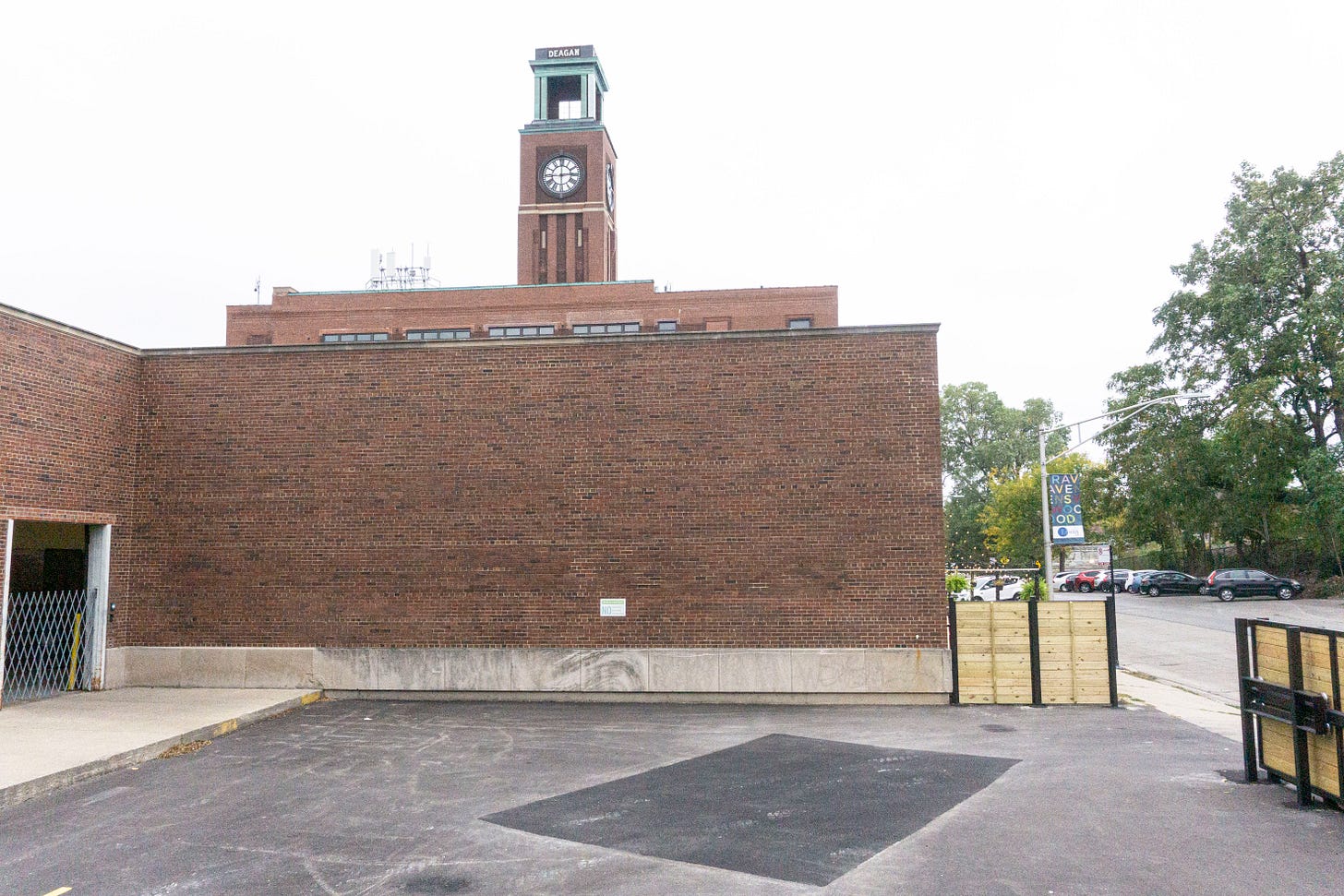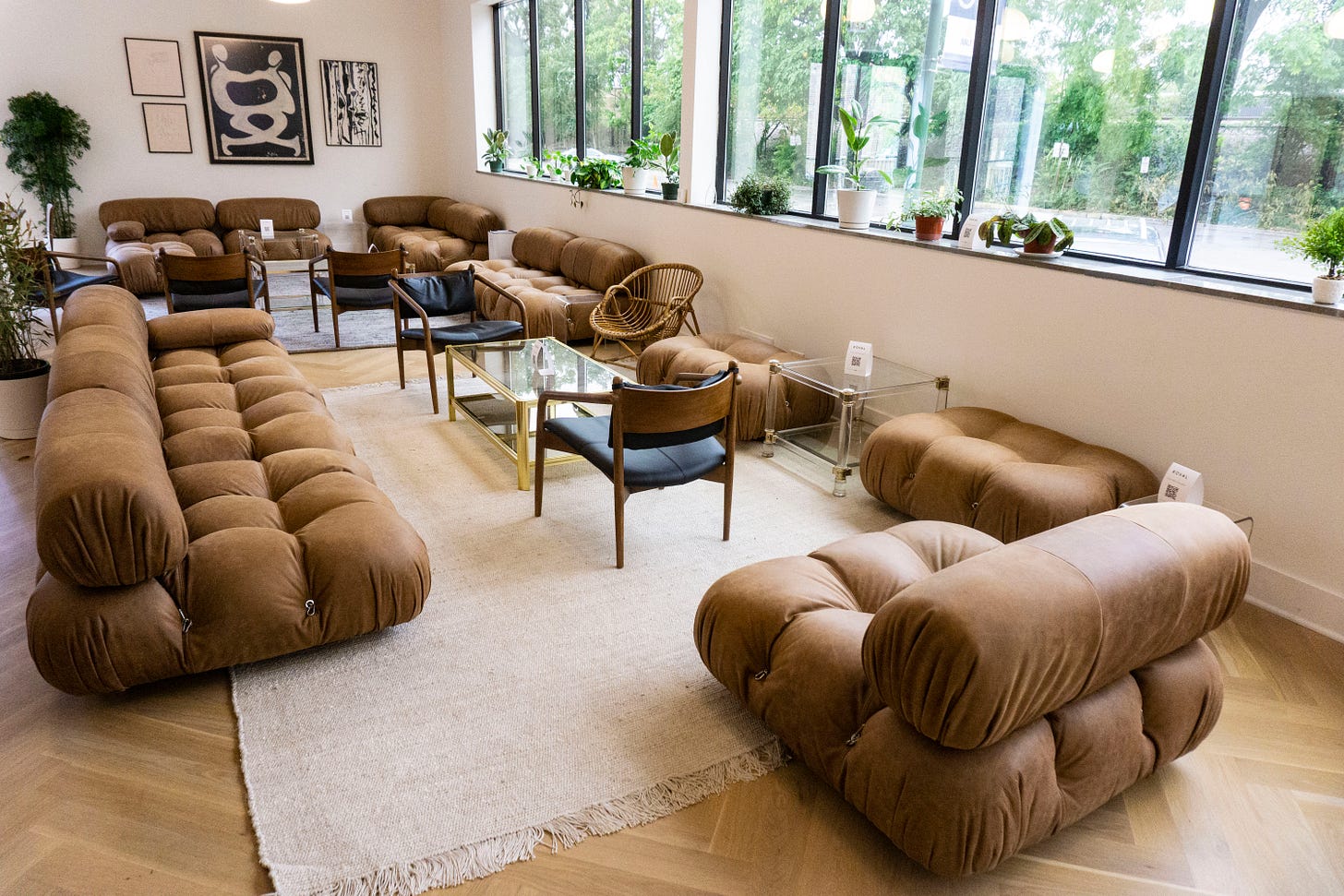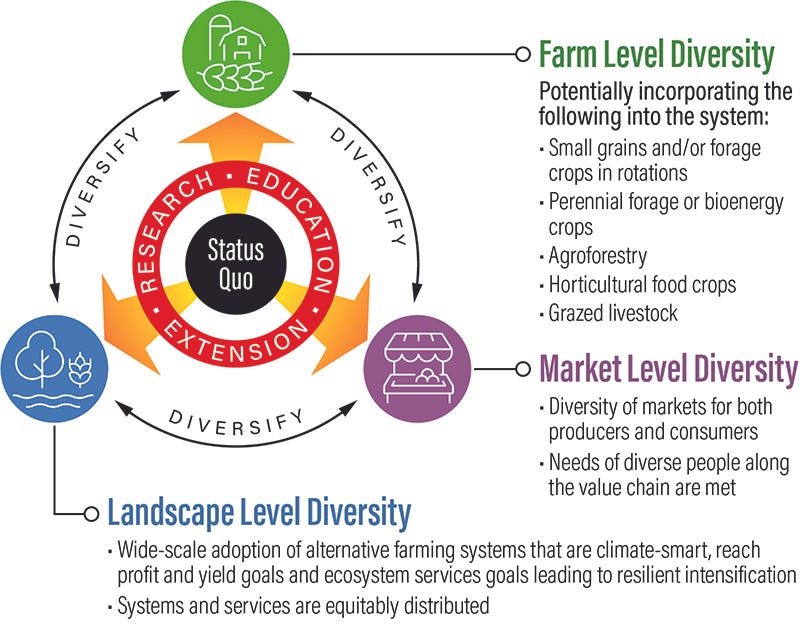Koval's Tasteful Tasting Room — At Last
Also, Purdue Gets $10 Million Grant to Research Midwest Farm Diversification
In This Issue
• Koval Distillery’s Tasteful Tasting Room Opens At Last
• Purdue University Getting a $10 Million USDA Grant to Study Farm Diversity

Koval Distillery’s Tasteful Tasting Room Opens At Last
Tasting rooms have been commonplace at our region’s craft distilleries, providing additional revenue streams while elevating the producers’ brands. Although Koval Distillery opened in 2008 as the first distillery within Chicago since before the Prohibition era, it was originally located in a small building, and a tasting room was not possible until it moved its plant into a larger building a few blocks south at 4241 N. Ravenswood Ave.
Planning began in 2017. Zoning changes to allow for the tasting room were obtained. Contractors were hired for a gut rehab that included asbestos abatement. And Koval was just getting ready in early 2020 to do its buildout, with a target for opening in spring of that year, when it — the COVID pandemic — happened, slowing the tasting room work to a crawl.
But last Friday (October 1), just about a year and a half later than planned, Koval opened the tasting room in what is now known at the Ravenswood neighborhood’s “Malt Row.”
I visited before opening on Tuesday to interview Dr. Sonat Birnecker Hart, who co-founded and runs Koval with husband Robert Birnecker. It is a cozy room with tables, plush couches and chairs, a hardwood floor, and a bar with a bespoke back bar lined with Koval’s organic whiskeys, gins, and liqueurs. A small outdoor patio adjoins.
The tasting room, open Tuesdays through Fridays from 5 to 10 p.m. and on weekends from noon to 10 p.m., has a menu that includes cocktails, flights, “perfect pairs” of Koval products with snack-sized food items, bread and cheese platters, desserts and coffee drinks.
The European vibe is no accident: Robert Birnecker comes from an Austrian family with a history of distilling. Along with their own distillery, Robert and Sonat runs Kothe Distilling Technologies, which has helped several dozen distillery startups get up and running.
Nonetheless, Koval was quite a career change for the couple. They previously lived in the Washington, D.C., area where Robert was press secretary for the Austrian embassy and Sonat — who holds a masters’ degree from Oxford in Jewish studies and a Ph.D. in German from the University of London — was a tenured professor in Jewish history.
Enjoy these excerpts from my interview with Sonat.

Q: So how long was this in the works?
A: It was in the works for quite a while. We had to start thinking about it probably in 2017, because the property itself, especially this part of the building, needed a lot of renovation... I mean, it was completely redone... Around that same time, in order to have this be a tasting room, we needed to get the zoning changed...
And then of course the pandemic happened, just as we were starting to do all the rehabbing. We finished gutting it. And then we were starting to do the refinement of this space. But, you know, with that, a lot of the people that work for our contractor, some people got sick, also materials became difficult to come by...
So there were so many delays, but at the end of the day, things happen when they're meant to happen. We just took it in stride, and are very thrilled to finally be in a situation in which we can welcome people.
Q: What are your goals for the tasting room?
A: We see the tasting room as a way to complete the entire visitor experience. We are hoping that some people will come and they'll be able to go on a tour and then they'll be able to relax on either our patio or in the tasting room after the tour and enjoy cocktails. But we're thrilled if people want to just come because they enjoy this spot for cocktails or even for coffee.
Really the concept is that this tasting room allows us to sort of welcome people into the home part of Koval. We've got the manufacturing side of Koval and we have our retail side, but this is really sort of our home….
We’re inspired by our heritage for the menu. There are a lot of Austrian and German things on the menu. The whole coffee section is very Viennese-focused. And yet we want to have options on the menu for people to be able to try our spirits, whether individually or in cocktails, and enjoy themselves and really see them featured as best as possible. And this tasting room allows us to really feature our entire line of products for people, not just in tasting form but also in cocktails, and and we've never been able to do that in the past. And so this is a real development of all of our offerings. It really completes the whole picture for us.
Q: Let’s talk about this Ravenswood neighborhood.
A: We love this neighborhood. We feel that what's great about it is this [tasting room] adds something else to Malt Row. People come to you, you can walk up Ravenswood and visit many different breweries and even a winery. And we're thrilled to be the distillery and it’s part of Malt Row.

Q: You're the first post-Prohibition distillery in Chicago, and you have so many trademark aspects like organic grain. So it would be easy for you to rest on your laurels, but you are innovating.
A: We are engaging in product development all the time. So we have a lot of products that are aging that we did a number of years ago but we're not ready to release them yet, including some collaborations with other craft brands in the Chicagoland area. So I look forward to being able to talk about those.
But this winter, we're coming out with a maple syrup rye. It's aged in maple syrup barrels, which is fun. iIt's going to have a nice fall touch to it, so I think that they'll be a fun one for the fall… We have a brandy coming out very soon, a pear brandy. We try and come out with a brandy every other year. So this is a new brandy that we'll be releasing and it should be available for the holidays.

Q: It's October. Do you have holiday event plans?
A: Oh, we sure do. There going to be so many different events and classes and workshops. All will be available for viewing on our website and we’ll be promoting on Facebook and other things. I know that upcoming, we have a Halloween cocktail class where people can learn some Halloween cocktails. But they'll be so many different types of things that we'll be doing, whether it's in the bar or on our patio, special tours and cocktail classes. So there's lots to do here now and more ways to do it, which is exciting.
Editor’s Note: Sonat and I also engaged in conversation about the state of the local and overall craft distilling industry. To keep this article at reasonable length, I will publish a follow-up article with this content soon.
Purdue Getting $10 Million to Study Farm Diversity
I was heartened yesterday to receive the news that Purdue University (West Lafayette, Indiana) has secured a $10 million grant from the U.S. Department of Agriculture’s National Institute of Food and Agriculture (USDA NIFA) that, in the university’s words, “seeks to make Midwestern agriculture more resilient by diversifying farms, marketing and the agricultural landscape.”
The goals of this important project are summarized in the graphic above and we’ll let Purdue’s press release below fill in the details. It’s exciting that this project is centered right here in our region and that the USDA is investing such a large sum on a project that could provide a roadmap for food systems change in the Midwest.
Maybe the times they are a-changin’.
_____________________
WEST LAFAYETTE, Ind. — A $10 million project seeks to make Midwestern agriculture more resilient by diversifying farms, marketing and the agricultural landscape.
We’ve all heard of hedging a bet or diversifying a portfolio to be able to weather ups and downs, and this is the same concept, said Linda Prokopy department head and professor of horticulture and landscape architecture at Purdue University, who leads the project.
“What’s new is that market and environmental research tailored to this part of the U.S. will inform our next moves, and individual farmers and stakeholders will be involved in every step of the process,” she says. “Growing only a rotation of corn and soybeans is not necessarily sustainable economically, environmentally or socially. We will be working with farmers in Indiana, Illinois and Iowa to evaluate alternative cropping systems that can be used in the Midwest – we will be evaluating small grains and/or forage crops in rotations, perennial forage or bioenergy crops, agroforestry, horticultural food crops and grazed livestock.”
The USDA National Institute of Food and Agriculture selected the project, titled “#DiverseCornBelt: Resilient Intensification through Diversity in Midwestern Agriculture,” which has a multidisciplinary team that spans the life, physical and social sciences.
”This project draws upon the talents of our faculty and can make a crucial contribution to diversifying Midwest agriculture. The lessons learned can benefit farmers throughout the region,” said Karen Plaut, the Glenn W. Sample Dean of Purdue’s College of Agriculture.
The team pulls expertise from across Purdue Agriculture. In addition to Prokopy, Purdue faculty on the team include Shalamar Armstrong, associate professor of agronomy; Steve Hallett, professor of horticulture and landscape architecture; Ian Kaplan, professor of entomology; Sarah LaRose, assistant professor of agricultural education; Elizabeth Maynard, clinical engagement associate professor of horticulture; Aaron Thompson, assistant professor of horticulture and landscape architecture; and Ariana Torres, associate professor of horticulture and landscape architecture and agricultural economics.
Kaplan specifically addressed the biophysical research component of the project.
“We are planning to collect large-scale field data across a wide range of cropping systems in the Corn Belt region — from Indiana to Iowa — that vary from traditional corn monocultures to highly diversified farms, he said. “This sampling effort will test how diversification practices at realistic spatial scales impact biophysical variables important to farmers. For example, we anticipate collecting data on soil health, water quality and insect biodiversity. By measuring these variables across three states, we will be able to understand how the implementation of specific farming practices simultaneously affect agroecosystem function, crop yields and long-term sustainability.”
Stakeholder listening sessions, surveys and interviews will also inform the five-year project, Prokopy said.
“We will examine the environmental costs and benefits of diversified systems through on-farm research, as well as identify economic and social barriers to change. The COVID-19 pandemic showed us the lack of resilience in our current system and how farmers suffered because of it,” she said. “We hope such pandemics will be rare, but, unfortunately, we can’t say the same about climate change. There will be challenges ahead and we must prepare for the future. We hope this project will bring together farmers, researchers and the agri-food community to figure out how.”
Letters of support for the team’s proposal came from farmers, industry, academic institutions and environmental organizations, including General Mills, Smithfield, Kellogg’s, Red Gold, the Indiana Agriculture Nutrient Alliance, the Indiana State Department of Agriculture, National Association of Conservation Districts, the Hoosier Young Farmers Coalition, the Iowa Soybean Association and the National Wildlife Federation.
#DiverseCornBelt’s Extension program will support farmers and local markets as they transition to a more diverse environment.
“We don’t know what kinds of diversification this project will identify as the most promising, but the Extension team will be ready to get the word out, help stakeholders evaluate the findings and provide resources needed to make changes for a more sustainable Midwest agriculture,” said Elizabeth Maynard, Extension specialist and clinical engagement associate professor of horticulture and landscape architecture.
The project also will engage the future workforce through educational modules and immersive learning experiences.
“Students will take field courses where they travel together and learn how to create a sustainable system,” Prokopy said. “It is like a study abroad course, but across the region. Students will learn from farmers, market organizers and researchers to gain a better sense of the entire agricultural system.”
Partner institutions on the project include the American Society of Agronomy, Conservation Technology Information Center, Sustainable Food Lab, USDA Economic Research Service, USDA Forest Service, Illinois State University, Iowa State University, Montana State University, The Nature Conservancy, Practical Farmers of Iowa, University of Illinois at Urbana-Champaign, University of Iowa, University of Minnesota, and University of Wisconsin-Madison and University of Wisconsin-Platteville.
Farmers, agricultural advisors and marketers, community leaders, and landowners, interested in participating in the project through surveys, interviews and stakeholder listening sessions should contact Prokopy at lprokopy@purdue.edu.
The U.S. Department of Agriculture’s National Institute of Food and Agriculture (Project No. 2021-68012-35896) funded this work.
Writer: Maureen Manier, mmanier@purdue,.edu
Source: Linda Prokopy; lprokopy@purdue.edu
Agricultural Communications: 765-494-8415;
Maureen Manier, Department Head, mmanier@purdue.edu





